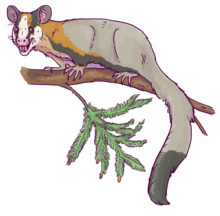Volaticotherium
| Volaticotherium | |
|---|---|

| |
| Holotype, Paleozoological Museum of China | |
| Scientific classification | |
| Domain: | Eukaryota |
| Kingdom: | Animalia |
| Phylum: | Chordata |
| Class: | Mammalia |
| Order: | †Eutriconodonta |
| Clade: | †Volaticotherini |
| Genus: | †Volaticotherium Meng et al., 2006 |
| Type species | |
| †Volaticotherium antiquum Meng et al., 2006[1]
| |
Volaticotherium antiquum (meaning "ancient gliding beast") is an extinct, gliding,
The discovery of Volaticotherium provided the earliest-known record of a gliding mammal (70 million years older than the next oldest example),[2] until the discovery of the contemporary haramiyidans Maiopatagium, Vilevolodon and Xianshou, and provided further evidence of mammalian diversity during the Mesozoic Era. The closely related and significantly older Argentoconodon shows similar post-cranial adaptations for aerial locomotion also seen in Volaticotherium.[3]
Discovery
The only known fossil of Volaticotherium was recovered from the
Description


Volaticotherium had a gliding membrane, sometimes compared to modern-day flying squirrel, that extended not just between the limbs and at least the tail base, but also the digits, "sandwiching" them. It was densely covered by fur.[5] The tail was flat, increasing the airfoil, and the limbs were proportionally long, comparable to those of modern flying and gliding mammals. The toes were grasping, as typical for arboreal mammals; the hand, however, was poorly preserved and its anatomy is therefore unclear.[5] The teeth of Volaticotherium were highly unusual, possessing long, curved, backwards-pointing cusps, possibly used for shearing; this, combined with the long canines, indicates a carnivorous diet, which at its small size was probably composed of insects. This is supported by a study ranking it among insectivorous taxa, while the related Argentoconodon ranked in carnivorous taxa.[6]
It has been noted that most gliding mammals are predominantly herbivorous,
Classification
The phylogenetic analysis conducted by the authors of the description of Volaticotherium antiquum recovered it as the
References
- ^ S2CID 28414039.
- Smithsonian Magazine. Retrieved 2008-02-22.
- ^ S2CID 85069761.
- PMID 22411790.
- ^ .
- ^ Jackson, Stephen Matthew and Schouten, Peter. Gliding Mammals of the World, Csiro Publishing, 2012
- ^ Zhe-Xi Luo; Qing-Jin Meng; David M. Grossnickle; Di Liu; April I. Neander; Yu-Guang Zhang; Qiang Ji (2017). “New evidence for mammaliaform ear evolution and feeding adaptation in a Jurassic ecosystem”. Nature. in press. doi:10.1038/nature23483.
- S2CID 28414039.
- S2CID 4317817.
- S2CID 16988665.
- ^ A. O. Averianov and A. V. Lopatin. 2011. Phylogeny of Triconodonts and Symmetrodonts and the Origin of Extant Mammals. Doklady Biological Sciences 436:32-35 [M. Uhen/M. Uhen]
- Meng, J.; Hu, Y.-M.; Wang, Y.-Q.; Wang, X.-L.; Li, C.-K. (2007). "Corrigendum: A Mesozoic gliding mammal from northeastern China". Nature. 446 (7131): 102. .
